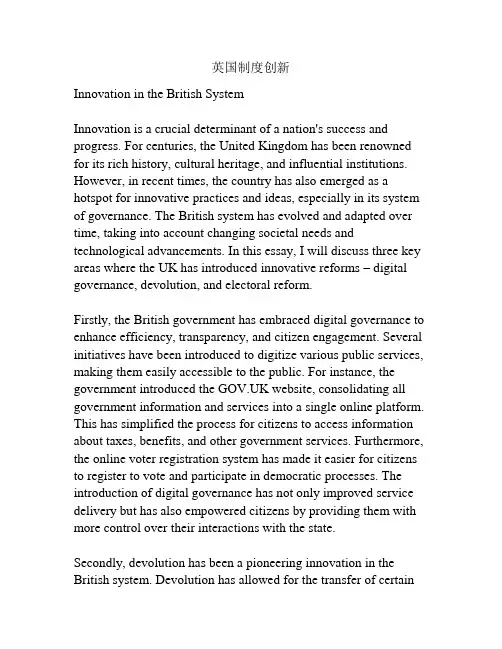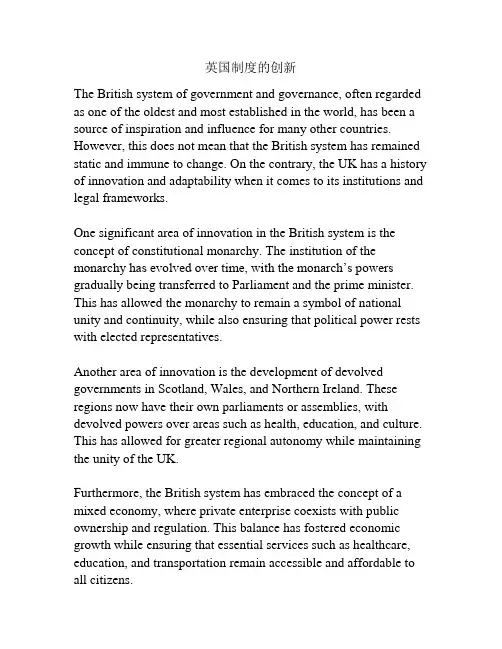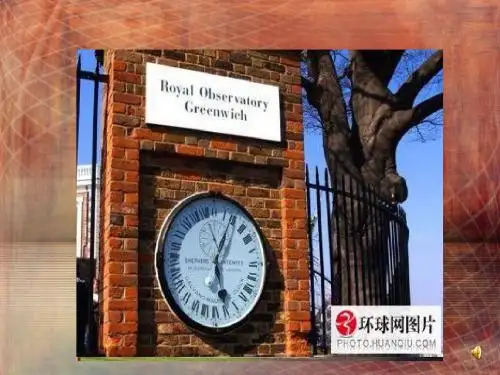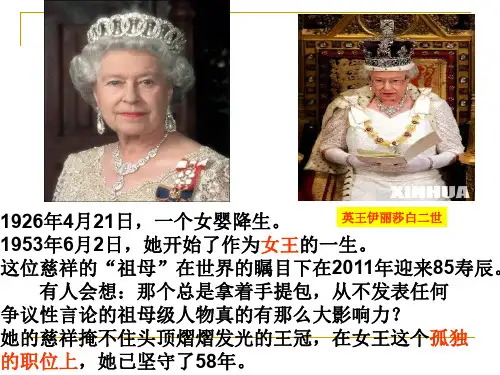《英国的制度创新》(终稿)
- 格式:doc
- 大小:22.50 KB
- 文档页数:7





英国制度创新Innovation in the British SystemInnovation is a crucial determinant of a nation's success and progress. For centuries, the United Kingdom has been renowned for its rich history, cultural heritage, and influential institutions. However, in recent times, the country has also emerged as a hotspot for innovative practices and ideas, especially in its system of governance. The British system has evolved and adapted over time, taking into account changing societal needs and technological advancements. In this essay, I will discuss three key areas where the UK has introduced innovative reforms – digital governance, devolution, and electoral reform.Firstly, the British government has embraced digital governance to enhance efficiency, transparency, and citizen engagement. Several initiatives have been introduced to digitize various public services, making them easily accessible to the public. For instance, the government introduced the website, consolidating all government information and services into a single online platform. This has simplified the process for citizens to access information about taxes, benefits, and other government services. Furthermore, the online voter registration system has made it easier for citizens to register to vote and participate in democratic processes. The introduction of digital governance has not only improved service delivery but has also empowered citizens by providing them with more control over their interactions with the state.Secondly, devolution has been a pioneering innovation in the British system. Devolution has allowed for the transfer of certainpowers and responsibilities from the central government to regional authorities, such as the Scottish Parliament, Welsh Assembly, and the Northern Ireland Assembly. This shift towards decentralization has recognized the diverse needs and aspirations of different regions within the United Kingdom. It has enabled local governments to make decisions that better reflect the preferences and interests of their constituents. Devolution has also fostered healthy competition among regions, stimulating innovation and economic growth. For instance, Scotland's devolved powers in education have allowed for the introduction of the Curriculum for Excellence, which focuses on developing skills and knowledge for the 21st-century workforce. Devolution has proven to be a successful innovation, ensuring greater regional autonomy and empowering local communities.Lastly, the UK has implemented various electoral reforms to enhance democratic processes and address concerns around representation. The introduction of proportional representation for devolved assemblies and the establishment of the Independent Boundary Commission for redrawing electoral boundaries are significant innovations. Proportional representation has allowed for a more accurate reflection of the voters' preferences and has provided smaller political parties with greater opportunities to be represented in government. This has resulted in more diverse and inclusive political systems. Additionally, the independent boundary commission ensures fair representation by periodically redistributing electoral boundaries based on population changes. These electoral reforms have contributed to strengthening the democratic fabric of the United Kingdom, increasing public trust in the electoral process.In conclusion, the United Kingdom has demonstrated a commitment to innovation in its system of governance. The introduction of digital governance, devolution, and electoral reforms showcases the country's ability to adapt and improve its institutions. These innovations have not only enhanced efficiency, transparency, and citizen engagement but have also empowered local communities and strengthened democratic processes. The British system serves as an inspiration for other nations seeking to enhance their governance systems through innovative reforms.。

英国制度的创新The British system of government and governance, often regarded as one of the oldest and most established in the world, has been a source of inspiration and influence for many other countries. However, this does not mean that the British system has remained static and immune to change. On the contrary, the UK has a history of innovation and adaptability when it comes to its institutions and legal frameworks.One significant area of innovation in the British system is the concept of constitutional monarchy. The institution of the monarchy has evolved over time, with the monarch’s powers gradually being transferred to Parliament and the prime minister. This has allowed the monarchy to remain a symbol of national unity and continuity, while also ensuring that political power rests with elected representatives.Another area of innovation is the development of devolved governments in Scotland, Wales, and Northern Ireland. These regions now have their own parliaments or assemblies, with devolved powers over areas such as health, education, and culture. This has allowed for greater regional autonomy while maintaining the unity of the UK.Furthermore, the British system has embraced the concept of a mixed economy, where private enterprise coexists with public ownership and regulation. This balance has fostered economic growth while ensuring that essential services such as healthcare, education, and transportation remain accessible and affordable to all citizens.In recent years, the British system has also responded to calls for greater accountability and transparency in governance. The creation of the Independent Parliamentary Standards Authority (IPSA) in 2009, for example, was a response to the expenses scandal which rocked British politics. IPSA now oversees MPs' expenses and ensures that they are in line with public expectations.Moreover, the UK has been at the forefront of digital innovation in governance. The creation of the Government Digital Service (GDS) in 2011 has transformed the way that citizens interact with the government. Online platforms such as have made it easier for people to access information, apply for services, and provide feedback. This digitization of government services has increased efficiency, reduced costs, and improved transparency.In addition, the UK has taken steps to promote diversity and inclusivity in its institutions. The introduction of the Equality Actin 2010 has advanced the rights of minority groups and protected against discrimination in various aspects of life, including employment, education, and public services. This has helped to create a more inclusive society and ensure equal opportunities for all.Lastly, the UK has championed the concept of the rule of law. The rule of law ensures that everyone is subject to the same legal principles and that the judiciary remains independent and impartial. This has created a stable and predictable legal framework that promotes trust and confidence in the system.In conclusion, the British system of government and governance has been a continuous source of innovation and adaptability. From the evolution of the monarchy to the creation of devolved governments, the UK has demonstrated a commitment to finding new ways to meet the changing needs of its society. The embrace of digital innovation, the promotion of diversity and inclusivity, and the commitment to the rule of law further illustrate the UK's determination to remain at the forefront of democratic governance.。





第8课英国的制度创新命题人:东明一中高一历史组祝孝娟班级_____________姓名______________座号___________制定和责任内阁制形成的史实,理解英国资产阶级君主立宪制的特点。
分析资产阶级代议制在西方政治发展中的作用。
①《大宪章》;②“光荣革命”;③《权利法案》;④英国责任内阁制的形成及特点;⑤英国1832年议会改革。
英国君主立宪制的确立过程;《权利法案》在君主立宪制形成过程中的作用。
【教学设计】1、什么是君主立宪制?英国的君主立宪制是怎么确立的?2、《权利法案》的主要内容有哪些?它的颁布意味着什么?【设计思路】利用“查尔斯王子的再婚”新闻报道,导入对君主立宪制的学习;通过对《权利法案》的解读,说明它在君主立宪制形成过程中的作用。
内阁制中君主、首相、责任内阁制之间的关系,英国代议制君主立宪制的特点。
【教学设计】1、模拟布莱尔出兵伊拉克虚拟情景,来调动学生的积极性。
2、把英国君主立宪制的特点这个难点转化为另外一个问题“英国几股重要政治力量——国王、首相、议会、内阁——分别在国家政治生活中扮演什么样的角色,之间的关系”,制作表格供学生讨论,制作示意图。
【设计思路】通过设置虚拟场景和制作“英国内阁权力分布”示意图,来分析内阁制各部门的关系,方法三:图示法:利用图来分析内阁制各部门的关系,并据此分析现代英国君主立宪制的特一、《权利法案》的制定1、背景:⑴历史传统:13世纪初,英国大贵族联合起来,迫使英王签署___________以限制_______,形成了召开_______________________________的制度。
⑵政治前提:1640年,英国资产阶级革命爆发。
1688年的________________最终解决了国王和议会的主权之争。
2、内容:确立了_____________,国王的权力受到___________的限制。
3、影响:建立了___________________政体,使英国统治方式从_________转向_______,英国社会从此进入长期稳定发展的时期。
英国的制度创新In recent years, the United Kingdom has been at the forefront of institutional innovation, introducing new structures and systems to improve governance and ensure efficiency. These initiatives have played a key role in modernizing the country and addressing various societal challenges. In this article, we will explore some of the notable institutional innovations in the UK.One of the most significant institutional innovations in the UK is the devolution of power. Devolution refers to the transfer of legislative and executive authority from the central government to regional administrations. The United Kingdom's devolved governments in Scotland, Wales, and Northern Ireland have been given powers in areas such as education, health, and transportation. This decentralization of power has allowed for tailored policies and services that better reflect the specific needs and aspirations of different regions.Another institutional innovation is the establishment of independent regulatory bodies. These bodies are responsible for regulating and overseeing various sectors such as telecommunications, energy, and finance. For example, Ofcom is an independent regulator of the communications industry, ensuring fair competition and protecting consumer interests. The creation of such regulatory bodies has increased transparency, accountability, and consumer confidence in these sectors.The introduction of public-private partnerships (PPPs) has also been a significant institutional innovation in the UK. PPPs involve collaboration between public sector organizations and privatecompanies to deliver public services and infrastructure projects. This approach has allowed for the mobilization of private sector expertise and investment, resulting in innovative and efficient solutions. For instance, PPPs have been instrumental in the construction of hospitals, schools, and transport infrastructure across the country.In recent years, the UK has also embraced digital innovations in its institutions. The Government Digital Service (GDS) was established to transform the delivery of public services by harnessing digital technology. The GDS has been instrumental in driving the digitization of government services, making them more accessible and user-friendly. For example, citizens can now complete tax returns online and access various government services through digital platforms. This digital transformation has not only improved efficiency but also enhanced citizen engagement and participation.Furthermore, the UK has introduced innovative approaches to criminal justice and rehabilitation. One notable example is the use of restorative justice, which focuses on repairing the harm caused by crime through dialogue and mediation between victims and offenders. This approach has been proven to reduce reoffending rates and promote rehabilitation by addressing the underlying causes of criminal behavior. Restorative justice has been successfully implemented in various parts of the UK, providing a more victim-centered and holistic approach to justice.In conclusion, the United Kingdom has been a pioneer in institutional innovation, constantly introducing new structures andsystems to improve governance and address societal challenges. From devolution of power to the establishment of independent regulatory bodies, these innovations have modernized the country and ensured efficient delivery of services. Additionally, the embrace of digital technologies and innovative approaches to criminal justice have further enhanced efficiency and citizen engagement. The UK's commitment to institutional innovation serves as an inspiration for other countries seeking to improve governance and meet the evolving needs of their societies.。
《英国的制度创新》(终稿)
一、教案目标:
1。
熟悉近代英国君主立宪制民主政体形成和发展的基本脉络,记忆重要历史人物、重要政治文件的名称及主要内容。
2、掌握内阁、首相、女王议会之间的相互关系。
3、理解英国君主立宪制的基本特点
二:教案重难点:
重点:《权利法案》、责任内阁制。
难点:英国君主立宪制的特点。
三、教案过程:
(一)导入新课:英国是现代西方的资本主义强国之一,同学们知道现在是谁在统治着英国吗?(由学生回答,再投影出英女王伊丽莎白二世和首相卡梅伦的相片),为什么英国是由女王和首相共同掌权?英国究竟实行的是什么政治制度?其实英国的这种政治制度在近代已经确立,并沿用至今。
这节课就让我们一起追溯英国这种政治制度是如何确立、发展、完善的。
(二)讲授新课:
一、从《大宪章》到《权利法案》
投影:《大宪章》签署的背景——中世纪的英国是一个封建君主专制的国家,英国国王有着至高无上的地位,国王把国家的土地分赐给贵族,贵族必须向国王提供劳役和赋役。
13世纪初,英国国王在对法兰西的战争中失利,为了夺回失地,英王向贵族进一步征税征兵,加重了贵族的负担,如果有贵族拒绝的,就会遭到国王的秘密杀害。
在这种背景下,1215年,贵族起兵,迫使英王签署了《大宪章》。
让学生阅读课本32页有关《大宪章》片段内容,结合背景,分析《大宪章》主要表达的思想,教师强调这是英国第一次明确国王也必须服从法律,没有人可以凌驾于法律之上。
这是后来《权利法案》的先声。
教师讲述:17世纪初,随着资本主义经济的发展,资产阶级和新贵族逐渐形成并壮大。
英国处在斯图亚特王朝的统治之下,斯图亚特王朝的詹姆士一世和查理一世信奉“君权神授”,厉行君主专制,经常触犯资产阶级的利益。
英国议会中的资产阶级和新贵族的代表,对国王推行的政策和专横行为不断进行指责,在议会中形成了反对派,他们支持《大宪章》,积极要求限制王权。
从1640年,英国爆发了资产阶级革命,1688年的“光荣革命”标志着英国资产阶级革命的完成。
国王是被议会“邀请“来的,国王权力的来源已不是上帝而是议会了,并制定了《权利法案》作为国王登基的条件。
让学生看《权利法案》部分内容,完成53页思考题:《权利法案》吸取了《大宪章》的什么思想?
答:确立了议会主权,国王的权力受到议会的明确限制,运用法律的方式限制国王的权力,这是《权利法案》吸取了《大宪章》的重要部分。
教师总结讲述:《权利法案》的颁布标志着英国确立的君主立宪制,也就是确立了英国沿用至今的政体,英国的统治方式从人治转向法治。
可见,从《大宪章》到《权利法案》过渡的历史就是政治权力进一步从国王向议会转移的历史。
过渡:《权利法案》限制了王权,加强了议会的权力,议会具有立法权、司法权、财政权,但《权利法案》还没有解决国家的行政的决策和执行问题,这是《权利法案》的一个局限性,
为了解决这个问题,内阁逐渐独立出来,英王逐渐成为一个“统而不治”的君主,责任内阁制逐渐发展成熟。
二、责任内阁制的形成
国王召集咨询会议本是英国的传统,革命后内阁作为国王的私人会议的成分减少了,而从议会多数党领袖中来遴选内阁成员也渐成惯例。
乔治一世让内阁自行处理国事,沃尔波尔就成了实际上的首相,全面主持政府工作。
内阁的全体成员对政府事务集体负责,并与首相在政治上共进退。
随着议会在光荣革命中的胜利,辉格党和托利党的地位更突出了。
首相和内阁必须从多数党选出,两党制逐渐形成。
展示英国政府的权利结构图
列举英国出兵伊拉克的例子:内阁首相布莱尔是由下议院多数党选举产生,所以他要出兵伊拉克,一般是很轻易就在下议院获得多数票数通过,但也有120多名工党议员对政府动议投出的反对票使首相布莱尔蒙受了打击。
那反对的那部分议员怎么办呢?他就需要首相为自己的决策进行辩护,但是无论辩论结果如何,只要下议院是多数票数通过了,最后英国就可以出兵伊拉克。
讲述这个例子,让学生讨论分析:在责任内阁制下,英国的议会和政府的关系是如何体现的?
学生讨论完后,教师总结:在责任内阁制下,英国的议会与政府的关系体现为:内阁必须得到下议院议员的支持,内阁设首相必须是下议院多数党的领袖。
如果议会通过了对政府的不信任案,内阁就要下台,或者宣布解散议会,重新进行选举。
这样,内阁制的建立使英国的立法机关得以控制行政,但又不减低后者的行政效率,调节了议会与政府的关系。
此外,也可以看得出:英国的内阁是对议会负责的。
综上,责任内阁制的形成,即是行政能力由国王向内阁转移的过程。
通过学习英国的责任内阁制,我们了解了英国的内阁。
在中国的古代的明朝,明成祖也设了内阁,那么我们比较一下:明代的内阁与英国的内阁有什么区别?(投影)
先由学生讨论分析,最后教师完善答案:英国的内阁制是资产阶级政治制度,是资产阶级民主政治的产物,其内阁制下的内阁是独立于国王之外的机构。
而中国的内阁制是封建制度之一,是皇帝强化封建统治的产物。
过渡:英国确立了君主立宪制的政体后,责任内阁制得到不断发展完善,但是,最初议会的权力基本上掌握在资本阶级化的大贵族手中,其他阶层根本无法参政,于是,各个阶层都为争取普选权而斗争,终于使政治民主化得到实现。
(三)结课
以设计问题的形式结课。
投影问题:一位英国的宪法权威人士曾说:“上下两院如果作出决定,就是把女王本人的死刑判决书送到她面前,她也不得不签字。
” 这句话说明了英王的什么地位?结合17世纪有关史实扼要说明英王地位的变化。
参考:(1)说明了英王在国家政治生活中没有实权,处于“统而不治”的地位。
(2)资产阶级革命前,英王实行封建专制统治,革命推翻了封建专制的君主制,革命后议会通过了《权利法案》,确立了君主立宪制。
总结:可见,英国政治发展的历史,就是国家权力由英王移转于议会,议会政治、政党政治不断发展,内阁制逐渐形成,民主范围不断扩大,具有英国特色的代议制度逐步形成与确立。
它为美国、法国、德国等后起的国家的民主政治体制的建立提供了范本
板书设计:
第8课渐进的制度创新
一、从《大宪章》到《权利法案》
(政治权力:国王议会)
1、《大宪章》
2、《权利法案》
标志:君主立宪制的确立个人统治集体统治
人治法治
二、责任内阁制的形成
(行政能力:国王内阁)
1、内阁制
1721年,沃尔波尔担任英国第一首相
内阁全体成员对政府事物集体负责
2、两党制
英国两党制演变大概过程
三、英国君主立宪制的特点
1、保留君主,但“统而不治”;
2、议会主权,以代议制为基础,责任内阁制为核心;
3、君主制、贵族制、民主制三者融为一体。
四、做几个练习题巩固本节课所学知识。
1(08上海)光荣革命后,英国政治体制发生了显著变化,表现在
A。
内阁首相由国王兼任
B。
王室成为政治统治中心
C。
君主立宪制度确立
D。
议会对内阁负责
2。
下列关于英国君主立宪制的表述,正确的是
①是融君主制、贵族制与民主制为一体的混合物②以议会内阁制为核心③国王有权废除任何法律④是资产阶级代议制
A。
①②③④B。
①②③
C。
①②④D。
②④
3。
英国国家政治生活中的最高决策者和领导者是A。
国王
B。
首相
C。
上院
D。
下院。